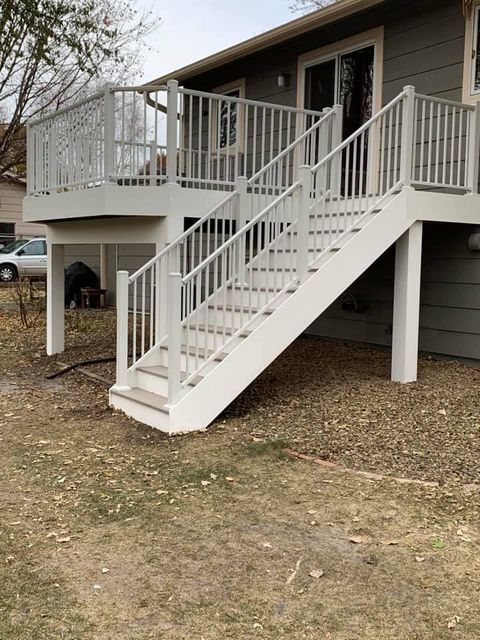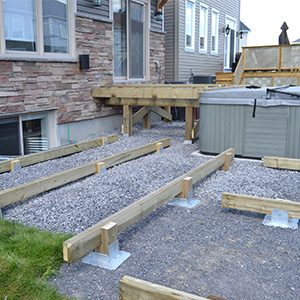Safeguard Structures, Enduring Perceptions: Grasping the Art of Deck Footings Installation
Safeguard Structures, Enduring Perceptions: Grasping the Art of Deck Footings Installation
Blog Article
Selecting the Right Deck Footings for Stability and Resilience
The long life and safety and security of your deck depend heavily on the kind of grounds you choose, as they offer the vital support and security to withstand the test of time. In this conversation, we will certainly discover the numerous types of deck grounds, think about the crucial aspects to evaluate when making a choice, and dive into the pros and cons of different choices.
Kinds Of Deck Footings
These grounds consist of a cylindrical hole filled with concrete, which provides a solid foundation for the deck messages. Concrete pier footings are relatively easy to install and provide exceptional security, making them a prominent option for lots of deck jobs.
One more type of footing is the helical stack footing. Helical piles are steel shafts with helical plates affixed to them. These grounds are mounted by screwing them right into the ground, which develops a safe and secure structure for the deck. Helical stack footings are suitable for locations with difficult soil problems, as they can be mounted in nearly any sort of dirt. They likewise enable easy adjustment and leveling of the deck if required.
Additionally, some home builders select precast concrete footings. These grounds are made of sturdy concrete and come in numerous sizes and shapes to suit different deck styles. Precast concrete grounds are practical to mount and supply a stable base for the deck framework.
Ultimately, one more alternative is the post-in-anchor ground system. This kind of ground includes driving a metal support into the ground and attaching it to the deck post. It uses adaptability in regards to placing the deck blog posts and appropriates for decks with light-weight structures.
When selecting the right kind of deck footing, it is necessary to consider factors such as dirt problems, deck load, and neighborhood building regulations (Deck Footings). Consulting with an expert service provider or structural designer can aid guarantee the ideal footing is selected for a stable and risk-free deck
Variables to Consider When Selecting Grounds
When selecting the proper grounds for a deck, it is essential to very carefully consider various aspects such as dirt conditions, deck tons, and adherence to regional building ordinance. These factors play a considerable function in making certain the security and resilience of the deck framework.
Among the key aspects to take into consideration is the dirt problems. The kind of soil on which the deck will be built identifies the sort of footings needed. Decks developed on sandy or loosened soils may require deeper footings to provide sufficient support and stop settling. On the other hand, decks improved clay or large soils might require grounds that can fit the soil's tendency to increase and agreement.
An additional essential element is the deck tons. The weight of the deck, including the products made use of and any prospective real-time loads such as furniture or events, must be considered when choosing footings. The footings need to be created to bear the weight of the deck and disperse it evenly to avoid any kind of structural issues or failures.
Lastly, adherence to neighborhood building ordinance is vital. Structure codes vary from area to area, and it is necessary to abide by the particular needs set by the neighborhood authorities. Deck Footings. These codes make certain that the deck is developed safely and satisfies the necessary criteria for structural honesty and load-bearing capacity
Concrete Grounds: Advantages And Disadvantages

Concrete footings supply a number of benefits and downsides when made use of as the foundation for a deck. On the silver lining, concrete footings provide superb stability and sturdiness. Concrete is a rigid and strong material that can sustain hefty lots and withstand different climate condition. It additionally has a lengthy lifespan, making it a reliable choice for long-lasting use.
One more advantage of concrete footings is their flexibility. They can be poured into different shapes and dimensions to accommodate numerous deck layouts and arrangements. Concrete grounds can be tailored to fit the details demands and needs of the deck framework.
Nevertheless, there are likewise some drawbacks to making use of concrete footings. This can enhance the overall price of the deck job and may require specialist help.

Helical Piers Vs. Sonotubes: Which Is Better?
In thinking about the structure options for a deck, the comparison between helical piers and sonotubes is important in figuring out the premium selection. Helical piers, additionally called screw heaps, are steel shafts with helical plates affixed to them. They are turned right into the ground making use of hydraulic equipment, giving a sturdy and secure structure for the deck. On the various other hand, sonotubes are round types made from cardboard or fiber material that are loaded with concrete. They are placed in a hole went into the ground and provide assistance for the deck.
The helical plates on the piers important link create a solid grip with the dirt, moving or preventing any kind of movement of the deck. Sonotubes, on the various other hand, rely exclusively on the concrete filling up for security, which may not supply the exact same level of toughness and resistance.
In regards to installation, helical piers are reasonably less complicated and faster to mount contrasted to sonotubes. The hydraulic machinery used to turn the piers into the ground makes certain a effective and fast process. official source Sonotubes, on the various other hand, need digging openings and pouring concrete, which can be time-consuming and labor-intensive.
Additionally, helical piers are a more versatile alternative. If needed, they can be used in different dirt problems and can be adjusted or strengthened. Sonotubes, on the various other hand, might require additional support, such as rebar, in specific dirt problems or locations with high load demands.
Choosing the Right Footings for Your Deck's Measurements
For optimum architectural honesty, it is important to meticulously select the suitable footings that line up with the measurements of your deck. The measurements of your deck, including its size, elevation, and size, play a substantial duty in determining the type and size of footings needed.
When choosing grounds for your deck, it is vital to take into consideration the load-bearing capacity of the soil. The weight of the deck, integrated with the weight of any furnishings or individuals on it, applies a substantial pressure on the footings (Deck Footings). As a result, it is critical to pick grounds that can adequately sustain this weight without sinking or changing gradually.
Larger decks with better dimensions require bigger footings to give adequate security and support. The form more information of the footings, whether they are round or square, depends on the design and design of the deck.
Conclusion
Finally, selecting the right deck grounds is vital for making sure stability and durability. Variables such as the kind of grounds, the deck's measurements, and the pros and cons of various options must be considered. Concrete footings supply strength and durability, yet may be a lot more time-consuming and costly to install. Helical piers and sonotubes have their own benefits and downsides. Ultimately, choosing the ideal grounds for your deck's details demands is vital for a successful and resilient structure.
These footings consist of a cylindrical opening loaded with concrete, which offers a strong structure for the deck blog posts. Concrete pier footings are reasonably easy to mount and offer outstanding security, making them a preferred choice for numerous deck tasks.
Precast concrete footings are convenient to install and supply a secure base for the deck structure.
It uses adaptability in terms of placing the deck articles and is suitable for decks with light-weight frameworks.
Concrete grounds use numerous benefits and downsides when utilized as the foundation for a deck.
Report this page